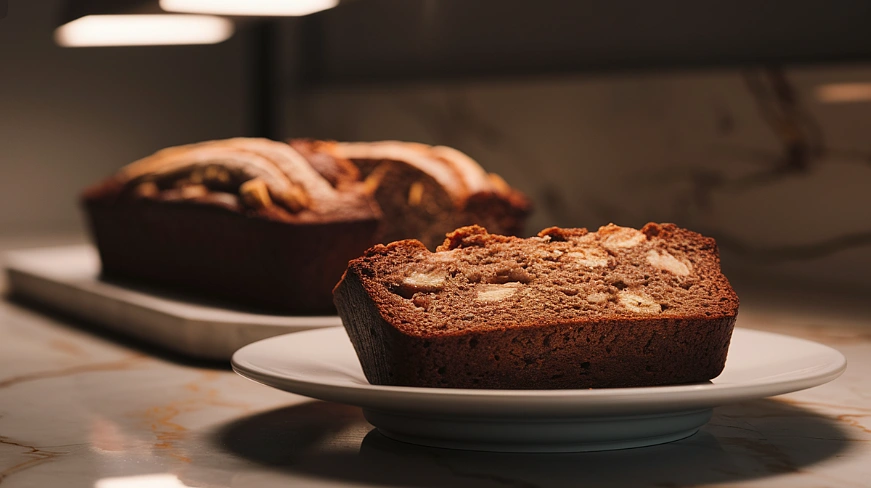Banana bread is a classic comfort food, loved by many for its moist texture, rich banana flavor, and ease of preparation. Whether you’re a seasoned baker or a beginner in the kitchen, this recipe is perfect for making a delicious loaf of banana bread that’s sure to please everyone. In this blog post, we’ll dive into the detailed steps of making banana bread, discuss tips for perfecting your loaf, explore variations of the recipe, and more.
Introduction to Banana Bread
Banana bread is a type of quick bread, meaning it doesn’t require yeast and instead uses baking soda or baking powder as a leavening agent. This makes it quick to prepare and bake, which is part of its appeal. The history of banana bread dates back to the 1930s in the United States, coinciding with the mass production of baking powder. As bananas became more widely available, cooks began incorporating them into bread recipes, resulting in the beloved banana bread we know today.
Ingredients
For this banana bread recipe, you’ll need the following ingredients:
- 3 ripe bananas: The riper the bananas, the better. Overripe bananas are sweeter and have a more intense flavor, making them perfect for banana bread.
- 1/3 cup melted butter: Butter adds richness and moisture to the bread.
- 1 teaspoon baking soda: This acts as a leavening agent, helping the bread rise and giving it a light texture.
- Pinch of salt: Salt enhances the flavor of the bread and balances the sweetness.
- 3/4 cup sugar: You can adjust the amount of sugar depending on your taste. Some prefer a sweeter loaf, while others like a more subtle sweetness.
- 1 large egg, beaten: The egg provides structure and helps bind the ingredients together.
- 1 teaspoon vanilla extract: Vanilla adds a warm, aromatic flavor that complements the bananas.
- 1 1/2 cups all-purpose flour: Flour is the base of the bread, giving it structure and substance.
Step-by-Step Instructions
- Preheat your oven to 350°F (175°C). Preparing your oven in advance ensures it’s at the correct temperature when your batter is ready to bake.
- Prepare your loaf pan by greasing it with butter or lining it with parchment paper. This step is crucial to prevent the bread from sticking to the pan.
- Mash the bananas in a mixing bowl until smooth. If you prefer a chunkier texture, leave a few small lumps.
- Add the melted butter to the mashed bananas and stir until combined.
- Mix in the baking soda and salt. These ingredients should be evenly distributed throughout the batter to ensure even rising and flavor.
- Stir in the sugar, beaten egg, and vanilla extract. Mix until smooth and all the ingredients are fully incorporated.
- Gradually add the flour to the mixture, stirring gently until just combined. Overmixing can result in a dense loaf, so mix just until you no longer see streaks of flour.
- Pour the batter into the prepared loaf pan. Use a spatula to smooth the top.
- Bake for 60-65 minutes, or until a toothpick inserted into the center comes out clean. The baking time can vary depending on your oven, so start checking around the 55-minute mark.
- Allow the bread to cool in the pan for 10 minutes, then transfer it to a wire rack to cool completely. This helps the bread set and makes it easier to slice.
Tips for Perfect Banana Bread
Making banana bread is simple, but these tips can help you achieve the best results:
- Use overripe bananas: Bananas with brown spots or even fully brown skins are perfect. They’re sweeter and more flavorful than just-ripe bananas.
- Don’t overmix the batter: Overmixing can develop the gluten in the flour, resulting in a tougher, denser bread. Stir until the ingredients are just combined.
- Add-ins and variations: Customize your banana bread by adding chocolate chips, nuts (like walnuts or pecans), or dried fruits. These add texture and extra flavor.
- Check for doneness: Because ovens can vary, the baking time might differ. Start checking your bread at the 55-minute mark. Insert a toothpick or knife into the center; if it comes out clean or with just a few crumbs, the bread is done.
Health Benefits of Banana Bread
Banana bread, while indulgent, offers some health benefits thanks to its main ingredient—bananas. Bananas are rich in potassium, which is essential for heart health and maintaining proper muscle and nerve function. They also provide dietary fiber, aiding in digestion and helping to keep you feeling full longer.
For those looking to make their banana bread a bit healthier, consider these modifications:
- Use whole wheat flour: Substituting half or all of the all-purpose flour with whole wheat flour can add fiber and nutrients.
- Reduce the sugar: Bananas add natural sweetness, so you can often reduce the sugar by 1/4 to 1/2 without sacrificing flavor.
- Add flaxseeds or chia seeds: These seeds boost the fiber and omega-3 content of the bread, making it more nutritious.
Variations of Banana Bread
Banana bread is a versatile recipe that can be easily adapted to suit your tastes or dietary needs. Here are some popular variations:
- Chocolate Banana Bread: Add 1/2 cup of cocoa powder to the batter for a rich chocolate flavor. You can also mix in chocolate chips for an extra treat.
- Nutty Banana Bread: Stir in 1/2 to 1 cup of chopped nuts like walnuts, pecans, or almonds. Nuts add a crunchy texture and a nutty flavor that pairs beautifully with the sweet bananas.
- Gluten-Free Banana Bread: Use a gluten-free all-purpose flour blend in place of regular flour. Ensure that your baking soda and other ingredients are gluten-free as well.
- Vegan Banana Bread: Replace the egg with a flax egg (1 tablespoon of ground flaxseed mixed with 3 tablespoons of water) and use coconut oil or a vegan butter substitute instead of regular butter.
- Banana Muffins: Divide the batter into a muffin tin instead of a loaf pan to make banana muffins. Bake at 350°F (175°C) for about 20-25 minutes.
The Cultural Significance of Banana Bread
Banana bread holds a special place in many households, especially in the United States. Its popularity surged during the Great Depression when resourcefulness in the kitchen was essential. Bananas, which might have gone to waste as they overripe, became a valuable ingredient in creating a comforting and filling treat. Today, banana bread continues to be a symbol of home baking and comfort, often made during times when people seek to bring a little joy and warmth into their lives.
Storing and Freezing Banana Bread
Banana bread can be stored at room temperature for up to four days. To keep it fresh, wrap the loaf in plastic wrap or store it in an airtight container. For longer storage, banana bread can be frozen for up to three months. Wrap the bread tightly in plastic wrap and then in aluminum foil or place it in a freezer-safe bag. Thaw it at room temperature or warm slices in the toaster or microwave before serving.
Frequently Asked Questions (FAQs)
1. Can I use bananas that are not overripe?
Yes, you can use bananas that are not fully overripe, but the flavor might be less intense, and the bread may not be as moist. If your bananas are not ripe enough, you can speed up the ripening process by placing them in a paper bag with an apple or by baking them in the oven at a low temperature for a few minutes.
2. Can I substitute the butter with oil?
Yes, you can substitute butter with an equal amount of vegetable oil or coconut oil. This can slightly alter the flavor and texture, making the bread a bit denser and moister.
3. How do I prevent my banana bread from being too dry?
To prevent dry banana bread, make sure you’re not overbaking it. Check your bread a few minutes before the suggested baking time. Also, avoid overmixing the batter, as this can lead to a tougher texture.
4. What can I add to banana bread for extra flavor?
You can add a variety of ingredients to banana bread for extra flavor, including spices like cinnamon or nutmeg, chocolate chips, nuts, or dried fruits like raisins or cranberries. These additions can elevate the flavor and make each loaf unique.
5. Can I make banana bread without eggs?
Yes, you can make banana bread without eggs by using substitutes like a flax egg, applesauce, or yogurt. These alternatives can provide the necessary moisture and binding properties that eggs typically offer.
Conclusion
Banana bread is a beloved recipe that has stood the test of time. Its simplicity, adaptability, and comforting flavor make it a staple in many kitchens. Whether you stick to the classic recipe or experiment with different variations, banana bread is a treat that brings warmth and joy to any occasion. Baking this bread not only fills your home with a delightful aroma but also provides a delicious way to use up overripe bananas. Enjoy a slice with your morning coffee, as an afternoon snack, or even as a dessert—banana bread is versatile enough to be enjoyed anytime.

